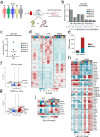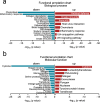Human macrophages infected with Egyptian Rousette bat-isolated Marburg virus display inter-individual susceptibility and antiviral responsiveness
- PMID: 40295691
- PMCID: PMC11721647
- DOI: 10.1038/s44298-024-00027-3
Human macrophages infected with Egyptian Rousette bat-isolated Marburg virus display inter-individual susceptibility and antiviral responsiveness
Abstract
Marburg virus (MARV) is a highly pathogenic filovirus and a causative agent of sporadic zoonotic viral hemorrhagic fever outbreaks with high case fatality rates. In humans, filoviruses like MARV and Zaire Ebola virus (EBOV) target, among others, innate immune cells like dendritic cells and macrophages (MΦs). Filovirus-infected dendritic cells display impaired maturation and antigen presentation, while MΦs become hyper-activated and secrete proinflammatory cytokines and chemokines. Our current understanding of human macrophage responses to MARV remains limited. Here, we used human monocyte-derived macrophages (moMΦs) to address how their phenotype, transcriptional profile, and protein expression change upon an in vitro infection with a bat isolate of MARV. Confirming its tropism for macrophages, we show that MARV induces notable shifts in their transcription distinct from responses induced by lipopolysaccharide (LPS), marked by upregulated gene expression of several chemokines, type I interferons, and IFN-stimulated genes. MARV infection also elicited pronounced inter-individually different transcriptional programs in moMΦs, the induction of Wnt signaling-associated genes, and the downregulation of multiple biological processes and molecular pathways.
© 2024. The Author(s).
Conflict of interest statement
Competing interests: The authors declare no competing interests.
Figures






Similar articles
-
Innate Immune Responses of Bat and Human Cells to Filoviruses: Commonalities and Distinctions.J Virol. 2017 Mar 29;91(8):e02471-16. doi: 10.1128/JVI.02471-16. Print 2017 Apr 15. J Virol. 2017. PMID: 28122983 Free PMC article.
-
Rousette Bat Dendritic Cells Overcome Marburg Virus-Mediated Antiviral Responses by Upregulation of Interferon-Related Genes While Downregulating Proinflammatory Disease Mediators.mSphere. 2019 Dec 4;4(6):e00728-19. doi: 10.1128/mSphere.00728-19. mSphere. 2019. PMID: 31801842 Free PMC article.
-
Impact of Měnglà Virus Proteins on Human and Bat Innate Immune Pathways.J Virol. 2020 Jun 16;94(13):e00191-20. doi: 10.1128/JVI.00191-20. Print 2020 Jun 16. J Virol. 2020. PMID: 32295912 Free PMC article.
-
Ebola and Marburg virus vaccines.Virus Genes. 2017 Aug;53(4):501-515. doi: 10.1007/s11262-017-1455-x. Epub 2017 Apr 26. Virus Genes. 2017. PMID: 28447193 Free PMC article. Review.
-
Filovirus Strategies to Escape Antiviral Responses.Curr Top Microbiol Immunol. 2017;411:293-322. doi: 10.1007/82_2017_13. Curr Top Microbiol Immunol. 2017. PMID: 28685291 Free PMC article. Review.
References
-
- Feldmann, H. Marburg hemorrhagic fever—the forgotten cousin strikes. N. Engl. J. Med.355, 866–869 (2006). - PubMed
-
- Gupta, M., Spiropoulou, C. & Rollin, P. E. Ebola virus infection of human PBMCs causes massive death of macrophages, CD4 and CD8 T cell sub-populations in vitro. Virology364, 45–54 (2007). - PubMed
Grants and funding
LinkOut - more resources
Full Text Sources

